 Go
to the Archive index
Go
to the Archive index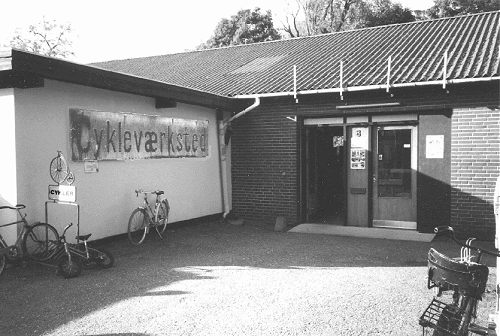
The main entrance to the museum. The sign saying
"Cykleværksted"
(cycle workshop) is made from outlawed Lucas bulls-eye rear
reflectors.
They were superceded by the multi-cellular type.
On 26th May, I once again loaded up my 2CV van and hitched up my caravan to set off to Denmark to take part in the Græsted Veterantræf with my steam-bicycle, (Buzzing, February 2002) together with my map-reading henchman, Dave Benn, and his 1982 high wheel "Ordinary" bicycle, which he rides in Victorian gentleman's costume. On a good road surface, the 2CV is now able to bound along at 50mph when towing the caravan two-up, as the new barrels and pistons that I fitted just prior to last year's Denmark trip are now well run-in.
Due to the henchman's insatiable hunger for a meat pie, then an hour and a half's traffic jam on the M25 south of the Dartford tunnel, we missed the Esbjerg ferry from Harwich by about 15 minutes, and so were compelled to camp for a couple of days in Harwich until the next ferry sailed to Esbjerg. This allowed me to do a few minor repairs to the van and I forged an additional stay for my towing mirror from an old bucket handle found on a derelict site in the town. We also had time to sample the delights of Harwich Maritime Museum, which is located in an old lighthouse building on the harbour edge and well worth a visit if you like ships as we do.
The Danish roads are an absolute joy to drive on. The volume of traffic is about one tenth as much as on English roads and they are very well surfaced. We did the 206 miles from Esbjerg to Græsted in about 4½ hours with a short stop for petrol (and no more food for Dave!) The great Bælt bridge that joins Funen to Zealand is a fantastic piece of Danish engineering, being 19km long and rising some 250ft above the water at the crest of the main span. When half-way across, the land either side is barely visible. The toll to cross with my van and caravan was 365 Danish Kroner, or about £33, each way.
We arrived in Græsted on the Saturday evening, ready to ride in the Veterantræf (steam rally) on Sunday and Monday (30th & 31st August). All went well except for a series of four consecutive front wheel punctures on the steam-bike on the Sunday. These were due to oil from the hub gearbox having run down a couple of spokes into the well of the rim, causing the butyl rubber inner tube to perish over the five years the steam bike has now been ridden. However a new tube was procured, and all was then well for the remainder of the rally.
In between mending the last puncture and fitting the new tube, Dave and I enthusiastically did a complete service on an English Elswick bicycle that a Danish lady had just bought in the flea-market. The vendor had sent her to me just to have her tyres pumped up, but we found her cones needed adjusting and her spokes were loose too, so we proved that there are still gentlemen in England and that the age of chivalry persists. Kristina bravely rode the bike back to Copenhagen later that evening, some thirty miles, after a refreshing cup of my organic Earl Grey tea and a few 78rpm gramophone records. A pleasant interlude. Incidentally, English bicycles are highly prized in Denmark it seems.
On the Tuesday,we visited the Museum Teknisk (Technical Museum) at Helsingor on the east coast of Zealand, on the invitation of Jens Breinegaard, the director, whom I met at the rally. Literally every aspect of 20th century technology is represented there, from aeroplanes to cars to radio and TV, and it was amazing to think that such a small country played a very important role in so many branches of technical achievement. Altogether the museum was very enlightening and highly civilised and tasteful in its presentation. Jens had a 1952 VéloSoleX that needed new piston rings, so we suggested he contact Roger Worton via the internet.
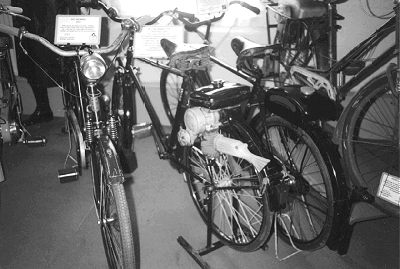
Danish cyclemotors in the museum
L to R: BFC, BFC, Diesella, Diesella.
Note Fishtail on the BFC.
The next day (Wednesday), we took the caravan down to a site in Sorø, to visit the nearby Dansk Cykel & Knallert museum in Glumsø. Translated this is the Danish Cycle and Moped Museum. This visit was by special invitation of Hans Verner Neumann, who is a friend of Peter, the museum curator, as normally the museum is only open at weekends at present. Gosh, what a place! Dave and I thought we'd died and gone to moped heaven! Danes are very fond of their cycles and mopeds, as is evident from the masses of machines that are to be seen parked at Danish railway stations, and that love was amply expressed at the museum. I was particularly interested in the Danish built mopeds and cyclemotors, and some examples on display were: BFC, Derby, Diesella, Jyden, SCO, Skylon, Grand, ICM, Lion and Wooler. Some other Danish makes were: Dream, Express, King, Metro, Mopedo, Mustad, Power, Radexi, Shadow, Speed, Star, Toanby, Tempo, Venus and Wittler. The BFC and Diesella were the most popular; the Diesella cyclemotor being the Power-Pak type, and good for 80kph (50mph) we were told, with spring forks up front.
Licencing of mopeds & cyclemotors in Denmark apparently falls into 3 categories dependant on max speed: 30kph, 50kph and 80kph. The 30kph machines are exempt from any formalities whatever, except maybe insurance. There were an astounding 3,000 names of cycles registered in Denmark, as cycle shops could put their own name on the head-tube if they so wished; it included sidecars and trailers for carrying children or trade goods. Hamlet was the largest Danish cycle maker.
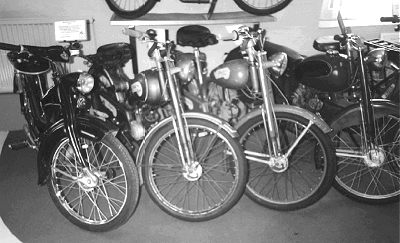
Danish mopeds in the museum L to R:
Wooler, Skylon, Skylon, Diesella.
Note the graceful pear-drop tanks.
An intriguing observation was that many Danish cyclemotors and mopeds seemed to have finely sculptured fish tails on their exhausts. Even the 750cc Nimbus had one for certain years. On enquiring about this I was told that Denmark being a maritime nation with a lot of coastline, many Danes were involved with the fishing industry. Thus, fish-tail style exhausts appealed to the Danish psyche, and the bikes that had them sold well. In addition to the above-mentioned exhibits, the museum has fine collections of old cameras and sewing machines, Hellesons battery products and a complete cycle shop and workshop that existed in trade from 1912-99 and was ran by 3 generations of the family of Anders Peter Larsen.
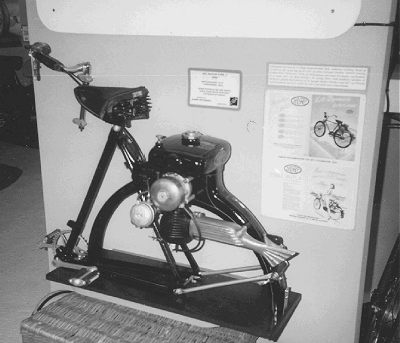
BFC cyclemotor on a dealer's advertising stand
illustrates the Danish liking for fish tailed exhausts
Outside in the museum yard and garden there are a whole host of unusual cycles that the visiting public are encouraged to try out, including a 'Long John' bicycle low-loader, a tandem, a semi-recumbent, an eccentric wheeled bicycle and a skate-bike (steered like a skateboard). Dave and I thought that a 'Long John' would be an excellent candidate for a cyclemotor, as you would then have a machine capable of carrying a hundredweight plus of freight or two children. Last year whilst in Copenhagen we saw several 'Long Johns' in use with children aboard being pedalled by fit looking young ladies. All in all I can say that the Dansk Cykel museum is well worth a visit.
Denmark is truly a breath of fresh air to anyone with our shared interests.The museum has a website: www.dckm.dk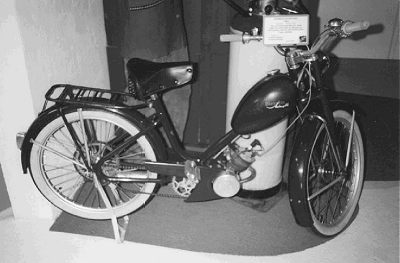
Diesella moped in the museum - I cannot remember the model!
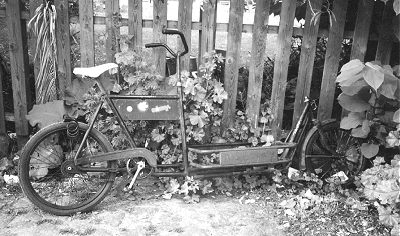
A 'Long John' carrier cycle seen in Copenhagen
First published, October 2004